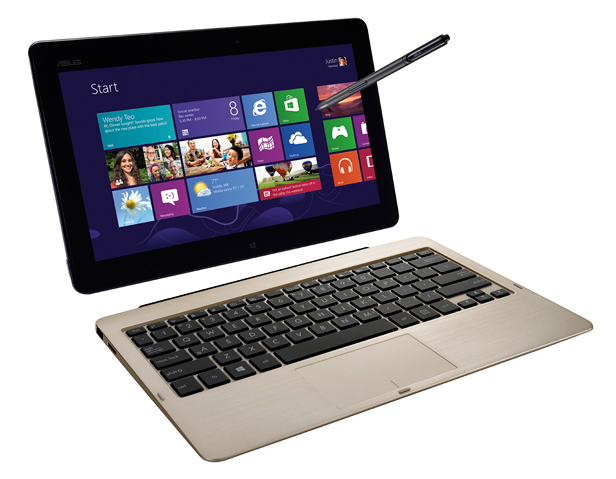Many Windows 8 Tablets Will Sport a Keyboard

The meteoric rise of Apple’s iPad has caused many people to neglect their laptops, or put off buying a new one. But many tablets released for Microsoft’s new Windows 8 operating system next month will attempt to make peace between the two formats—they’ll ship with snap-on keyboards.
Major computer manufacturers, including Hewlett-Packard, Asus, Acer, and Samsung, are all readying convertible tablets. Of the many sleek slabs in black, white, or silvery gray shown off at an event in San Francisco on Thursday held by chip maker Intel to highlight its newest Atom processor, almost all will be available with a detachable keyboard.
Computer manufacturers are struggling to catch up with Apple, which essentially created the tablet market in 2010 with the release of the iPad. Tablets had been offered before by other companies, but Apple was the first to successfully sell consumers on the idea of a thin slab that operates somewhere between a smartphone and a laptop computer. Some analysts say there is evidence the iPad has eaten into the revenues of other computer manufacturers by causing people to decide against buying a laptop.
A slew of companies have released tablets in the iPad’s wake, mostly using Google’s Android operating software, but these have largely failed to take off. A fresh generation of Atom chips from Intel, combined with the release of Windows 8 on October 26, provides electronics manufacturers with another chance. The new chips have design changes intended to make them more power-efficient for longer battery lives, while Windows 8 is designed to work equally well on both tablets and desktop computers (see “Microsoft Gambles on a Tablet-Centric Future”). Offering tablets with detachable keyboards that integrate smartly into a device’s design is intended to make this do-over a success, creating devices intended to appeal to both to consumers and business users.
Samsung showed off the latest version of its Slate tablet, a grayish device with a bright touch screen measuring 11.6 inches at the diagonal. It comes with a pressure-sensing stylus called the S-Pen, and will sell with an optional detachable keyboard that uses magnets and latching hardware to stay in place. Unlike most of the devices shown at the event, the Slate had a price and release date: it will be available October 26, the same day Windows 8 launches, for $749 with the keyboard and $649 without.
Allison Kohn, public relations manager for Samsung Electronics America, said the company decided to pair the tablet with a keyboard to help users carry around fewer gadgets. “It simplifies your lifestyle, being able to consolidate your devices,” she said.
Asus displayed the Vivo Tab, along with an optional keyboard containing a battery that can add about nine hours to the tablet’s overall battery life. Intel says that tablets built with the latest Atom processor can get over 10 hours of battery life. The tablet, which has an 11.6-inch screen, will also go on sale on October 26. Asus was one of the first to experiment with convertible tablets, with a model called the Eee Pad Transformer, initially released in 2011. Spokeswoman Xi Min Sam said that 80 to 90 percent of people who bought the Transformer tablets bought the detachable keyboard, too, seeing it as extending the functionality of a tablet.
One presenter at the event whose new tablet won’t include a keyboard is Dell. Buyers of the Latitude 10—which has a 10.1-inch display and a removable battery—will also have the option to purchase a docking station, though, with a smattering of USB ports that will let you plug in, among other accessories, a keyboard.
Keep Reading
Most Popular
Large language models can do jaw-dropping things. But nobody knows exactly why.
And that's a problem. Figuring it out is one of the biggest scientific puzzles of our time and a crucial step towards controlling more powerful future models.
The problem with plug-in hybrids? Their drivers.
Plug-in hybrids are often sold as a transition to EVs, but new data from Europe shows we’re still underestimating the emissions they produce.
Google DeepMind’s new generative model makes Super Mario–like games from scratch
Genie learns how to control games by watching hours and hours of video. It could help train next-gen robots too.
How scientists traced a mysterious covid case back to six toilets
When wastewater surveillance turns into a hunt for a single infected individual, the ethics get tricky.
Stay connected
Get the latest updates from
MIT Technology Review
Discover special offers, top stories, upcoming events, and more.